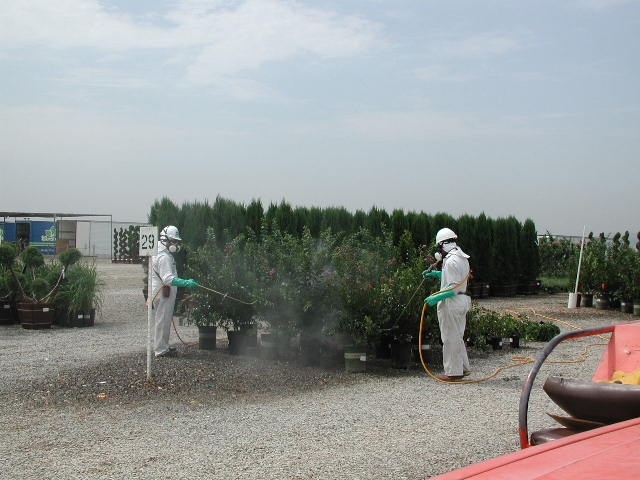Insecticides play an important role in pest management efforts in California, but it's very important to keep sprays on-target. Improper targeting or poorly maintained equipment can cause spray drift, which can result in unnecessary exposure to people, wildlife and the environment. With that in mind, your application technique and equipment maintenance are keys to reducing the movement of insecticides.
Spray drift occurs when spray droplets are carried from the application site and deposited on non-target sites. Spray drift can also occur from vapor drift (evaporation of insecticide from a plant surface) and particle drift (spray carrier droplets evaporate, leaving concentrated insecticide droplets). Spray drift is influenced mainly by droplet size; the larger the droplet, the less likely it will be carried off-site. Since small droplets are lighter and remain airborne longer than larger ones, they travel greater distances from the treatment site. A high spray height or wide nozzle tip angle will also increase drift distance. Several environmental and spray conditions affecting spray drift potential are shown below:
|
Factor |
More Drift |
Less Drift |
|
Nozzle Type |
Fine droplets |
Coarse droplets |
|
Nozzle Orifice Size |
Smaller |
Larger |
|
Nozzle Height |
Higher |
Lower |
|
Spray Pressure |
Higher |
Lower |
|
Wind Speed |
Higher |
Lower |
|
Air Temperature |
Higher |
Lower |
|
Relative Humidity |
Lower |
Higher |
|
Air Stability |
Vertically Stable |
Vertical Movement |
|
Insecticide Volatility |
Volatile |
Non-volatile |
To increase pest control success and reduce the likelihood of spray drift, consider the following application factors before
spraying:
- Label Instructions: Carefully read and follow directions before applying
- Environmental Conditions: Take weather conditions into consideration before spraying (i.e. wind, rain, fog, temperature, time of day, etc.).
- Buffer Zones: Leave adequate space between treatment site and non-targets.
- The Sprayer: Maintain equipment and calibrate for efficient use of insecticides.
- Nozzle Selection: Using a spray nozzle that emits large droplets is less prone to drift Spray Pressure: Keep spray pressure as low as possible according to the label instructions.
- Spray Volume: Check nozzle tip wear frequently and change when the flow rate differs by 10% from that of a new nozzle.
- Boom & Nozzle Height: Operate nozzles at their lowest recommended height.
- Travel Speed: Use a travel speed of 3-5 mph. Above 6 mph can create a wind-sheer effect on spray droplets.
- Spray Additives: Spray drift retardants can reduce drift by up to 95%.
*Adapted from Kurt Hembree and Stephen Vasquez-Farm Advisory, UCCE, Fresno County

